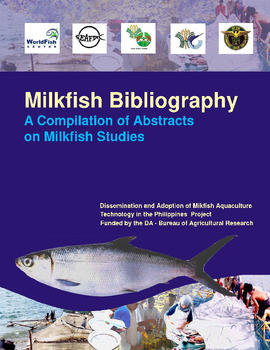Histopathology of chlorella-feeding in larval milkfish, Chanos chanos
- Global styles
- MLA
- Vancouver
- Elsevier - Harvard
- APA
- Help

View/
Date
1986Page views
3,077ASFA keyword
AGROVOC keyword
Taxonomic term
Metadata
Show full item record
Share
Abstract
Unicellular algae, particularly Chlorella, are widely used as starter feeds for marine finfish larvae. However, milk fish larvae when reared on Chlorella sp., suffered morality up to 100% within the first days of feeding (Fig. 1). Morality induced by Chlorella occurred earlier than that induced by starvation. The present Communication describes histopathological changes in liver and intestines of mlikfish larvae fed with Chlorella sp., copared with starvedor Artemia-fed fish. Feeding the larvea with Artemia for 7 days evofed (Ø 12-16 micro m) hepatocytes, with a well-developed and orderly arranged rough endoplasmic reticulum (rER). Greater amounts of glycogen were deposited. Whereas those fed with Chlorella (Fig. 2) resulted in cellular shrinkage (Ø 5-7micro m), complete absence of stored products, degeneration of rER. swelling of mitochondria and augmentation of lysosome-like structures (compare also Juario & Storch 1984). Starvation-related alterations of hepatocyte ultrastructure were essentially similar.
The intestinal tract of milkfish larvae is subdivided into pharynx, esophagus, stomach, intestines I(making up to 70% of gut length), II(up to 20%), and III (up to 10%). Nutritional related changes were only observed in intestines I and II. In Artemia-fed specimens there was intensive lipid absorption in I (Fig. 3) and well-developed supranuclear vacuoles in II (Fig. 4). Under starvation, The first part of the intestine was characterized by partial cellular hydrops, autolyic vacuoles (Fig. 5) and a dissolution of basal labyrinth. The supranuclear vacuoles of II were reduced to smaller, electron dense inclusions (Fig. 6). Chlorells appeared partially digested in the gut. It evoked pathological intrcellular vacuolation of the epithelial cells and bizarre forms of the nuclei in I (Fig. 7). In II, changes were similar to starved larvae (fig. 8).
The present report is another example of high moralities occurring among fish larvae reared on live feeds (compare Eckmann 1985).
Type
Conference paperCollections
- Conference Proceedings [299]
Related items
Showing items related by title, author, creator and subject.
-
Milkfish bibliography: a compilation of abstracts on milkfish studies
WorldFish Center (WorldFish Center, 2007)Milkfish Bibliography covers 700 references on milkfish biology; broodstock management and fry, fingerling and egg collection and production; milkfish culture systems; health and nutrition; post harvest technology; ... -
Ongoing research studies on maturation and spawning of milkfish, Chanos chanos at the brackishwater shrimp and milkfish culture applied research and training project, Jepara, Indonesia
Alikunhi, K. H. (Aquaculture Department, Southeast Asian Fisheries Development Center, 1976)The paper gives an account of the research work carried out at Jepara, Indonesia, on induction of maturity of milkfish in ponds and enclosures, and procurement of the spawners from the wild for seed production by hypophysation. ... -
Ration reduction, integrated multitrophic aquaculture (milkfish-seaweed-sea cucumber) and value-added products to improve incomes and reduce the ecological footprint of milkfish culture in the Philippines
de Jesus-Ayson, Evelyn Grace T.; Borski, Russel J. (AquaFish Collaborative Research Support Program, Oregon State University, 2012)In the Philippines, cage culture of milkfish in marine environments is increasing. The practice uses high stocking densities, with significantly greater inputs of artificial feeds which more often than not, have led to ...





